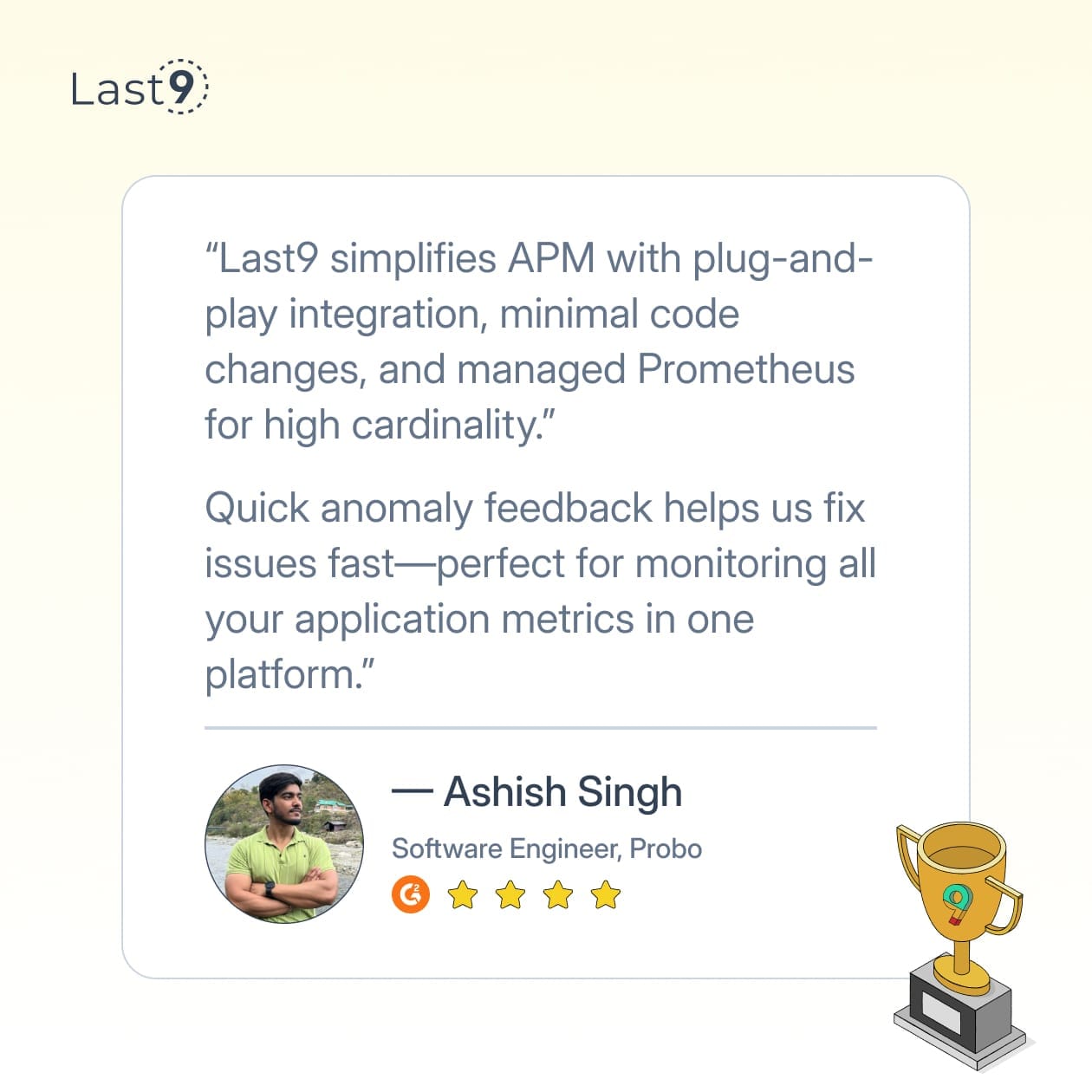If you're working with telemetry data, you've likely run into OpenTelemetry and its two main components: collectors and exporters. Both handle your observability data, but they do it in different ways and serve different purposes.
As a DevOps professional, choosing between these options affects everything from performance to maintenance overhead. This practical guide explains what each component does, when to use it, and how to implement it effectively.
What is OpenTelemetry?
Before jumping into collectors and exporters, let's get everyone on the same page about OpenTelemetry itself.
OpenTelemetry (often abbreviated as OTel) is an open-source observability framework for cloud-native software. It provides a collection of tools, APIs, and SDKs to generate, collect, and export telemetry data (metrics, logs, and traces) for analysis in observability platforms.
Consider it as the universal translator for all your monitoring data. It helps standardize how you gather and send that data, regardless of which monitoring tools you're using.
OpenTelemetry Collector: The Complete Package
The OpenTelemetry Collector serves as a standalone service that works between your applications and your observability backend.
What a Collector Does
An OpenTelemetry Collector is a dedicated service that receives, processes, and exports telemetry data. It acts as a middleman between your applications and your observability backend, offering several key functions:
- Receiving: Accepts data in multiple formats (OpenTelemetry, Jaeger, Zipkin, Prometheus)
- Processing: Transforms, filters, and batches the data
- Exporting: Sends the processed data to one or more backends
The collector comes in two distributions:
- Core: Contains only OpenTelemetry components
- Contrib: Includes the core plus community-contributed components
Collector Components Architecture
The OpenTelemetry Collector has a modular architecture consisting of three main component types:
- Receivers: These components receive data from various sources. They can accept data in different formats like OTLP, Jaeger, Zipkin, or Prometheus, and convert it to the internal OpenTelemetry format.
- Processors: These components process the data before it's exported. Common processors include:
batch: Groups data for more efficient sendingmemory_limiter: Prevents memory overloadfilter: Removes unwanted datatail_sampling: Samples traces based on their contentsresource: Modifies resource attributes
- Exporters: These components send data to backends. Exporters can output to observability platforms, file systems, logging systems, or even other collectors.
Data flows through these components in pipelines, which you define in your collector configuration file:
Receivers → Processors → ExportersWhen to Use a Collector
You'll want to consider using an OpenTelemetry Collector when:
- You need to send telemetry to multiple backends
- You want to pre-process data before it reaches your storage
- You're looking to reduce the load on your applications
- You need to handle temporary backend outages with buffering
- You're working with high-throughput systems
# Example collector configuration
receivers:
otlp:
protocols:
grpc:
endpoint: 0.0.0.0:4317
http:
endpoint: 0.0.0.0:4318
processors:
batch:
timeout: 1s
send_batch_size: 1024
memory_limiter:
check_interval: 1s
limit_mib: 1000
exporters:
prometheus:
endpoint: 0.0.0.0:8889
logging:
verbosity: detailed
extensions:
health_check:
endpoint: 0.0.0.0:13133
pprof:
endpoint: 0.0.0.0:1777
service:
extensions: [health_check, pprof]
pipelines:
metrics:
receivers: [otlp]
processors: [batch, memory_limiter]
exporters: [prometheus, logging]This configuration demonstrates the four main sections of a collector config file:
- Receivers: Define data input methods
- Processors: Configure data manipulation steps
- Exporters: Specify where data gets sent
- Service: Connect everything into pipelines
You can customize this configuration for specific backends. For example, here's how you might configure an exporter for Last9:
exporters:
otlp:
endpoint: "ingest.last9.io:4317"
headers:
"api-key": "${LAST9_API_KEY}"
tls:
insecure: falseOpenTelemetry Exporter: The Direct Line
An OpenTelemetry exporter is a component that sends telemetry data directly from your application to a backend.
What an Exporter Does
Exporters are libraries integrated directly into your application code that:
- Convert telemetry data to the format needed by your backend
- Send the data directly to your observability platform
- Work within your application's process
The key distinction here is that exporters run within your application, not as a separate service.
Types of Exporters
OpenTelemetry offers several types of exporters:
- OTLP Exporter: Sends data using the OpenTelemetry Protocol (recommended)
- Vendor-specific exporters: Formatted for specific backends like Jaeger or Zipkin
- Standard exporters: Like Prometheus, which many tools can read
- Debug exporters: For local debugging (console, file output)
When to Use an Exporter
Choose an exporter when:
- You have a simple setup with a single backend
- You want to minimize infrastructure components
- You're starting with observability and want a quick setup
- Your application has low to moderate telemetry volume
- You don't need advanced data processing or filtering
# Python exporter example
from opentelemetry.exporter.otlp.proto.grpc.trace_exporter import OTLPSpanExporter
from opentelemetry.sdk.trace import TracerProvider
from opentelemetry.sdk.trace.export import BatchSpanProcessor
tracer_provider = TracerProvider()
span_processor = BatchSpanProcessor(OTLPSpanExporter(endpoint="your-backend:4317"))
tracer_provider.add_span_processor(span_processor)OpenTelemetry Collector vs Exporter: Key Differences
Now that we understand what each component does, let's break down the major differences between them:
| Feature | OpenTelemetry Collector | OpenTelemetry Exporter |
|---|---|---|
| Deployment | Standalone service | Library in your app |
| Resource usage | Uses separate resources | Uses application resources |
| Processing capabilities | Advanced filtering, batching, transformation | Basic conversion |
| Backend flexibility | Can send to multiple backends simultaneously | Typically sends to one backend |
| Buffering | Can buffer during outages | Limited buffering |
| Configuration | External config file | Application code |
| Maintenance | Separate from application | Updated with app code |
| Scaling | Can be scaled independently | Scales with your app |
Performance Impact: How Each Affects Your Infrastructure
When picking between a collector and an exporter, performance is a key factor. Here's how they stack up:
Collector Performance
- Pros: Offloads processing from your application, can be optimized independently
- Cons: Adds network hops, requires additional infrastructure
Exporter Performance
- Pros: Direct transmission, no extra network hops
- Cons: Uses application resources, can impact application performance under load
Deployment Strategies: Implementing Collectors & Exporters
Let's look at common implementation patterns for both options.
Collector Deployment Patterns
- Agent per host: Deploy the collector as a sidecar or agent on each host
- Gateway pattern: Deploy collectors as a centralized service that all apps send to
- Hierarchical pattern: Use both agent collectors and gateway collectors
Collector vs Agent Terminology
You'll often hear "collector" and "agent" used interchangeably, but there's a subtle distinction:
- Collector: Generally refers to the OpenTelemetry Collector software itself
- Agent: Typically refers to a deployment pattern where the collector runs alongside the application (as a sidecar or on the same host)
In the OpenTelemetry ecosystem, an agent is just a collector deployed in a specific way—there's no separate "agent" software component.
Exporter Implementation Patterns
- Direct export: Applications export directly to your backend
- Export to collector: Applications use an exporter to send to a collector
- Mixed approach: Critical services use direct export while others go through collectors
Security & Best Practices: Optimizing Your Telemetry Pipeline
No matter which option you pick, follow these best practices:
- Start simple: Begin with exporters for quick wins
- Evolve gradually: Add collectors as complexity increases
- Monitor your monitoring: Apply observability to your telemetry pipeline
- Batch your data: Use batching to reduce network overhead
- Set sampling strategies: Sample traces in high-volume environments
Security Considerations
Security is crucial for your telemetry pipeline. Here are key practices to implement:
- TLS encryption: Always encrypt data in transit between exporters, collectors, and backends
- Authentication: Use API tokens or certificates for collector-to-backend communication
- Authorization: Limit collector access to only necessary resources
- Collector hardening: Run collectors with minimal permissions
- Sensitive data handling: Filter out PII and sensitive data before it leaves your network
Integration with Service Mesh
If you're using a service mesh like Istio or Linkerd, you can enhance your OpenTelemetry implementation:
- Service meshes often provide built-in telemetry that can complement OpenTelemetry
- You can configure your mesh to forward telemetry data to your collectors
- For Kubernetes environments, consider deploying collectors as a DaemonSet to capture service mesh metrics
Integration Options: Compatible Observability Platforms
OpenTelemetry's vendor-neutral approach means you can integrate with many different observability backends. Here's a breakdown of popular options:
Open-Source Solutions
- Prometheus: The standard for metrics collection and alerting. Works well with OpenTelemetry collectors for metrics.
- Jaeger: Purpose-built for distributed tracing. Native support for OpenTelemetry trace formats.
- Grafana: Visualization platform that works with various data sources. Excellent for creating comprehensive dashboards.
- OpenSearch: Fork of Elasticsearch that's fully open-source. Great for log storage and analysis.
- Tempo: Grafana's distributed tracing backend is designed for massive scale.
- Mimir: Horizontally scalable, highly available, multi-tenant metrics solution.
- Loki: Log aggregation system designed to be cost-effective.
Commercial & Managed Solutions
- Last9: Managed observability platform that handles high-cardinality data at scale. Integrates with OpenTelemetry and Prometheus, unifying metrics, logs, and traces for correlated monitoring and alerting.
- Lightstep: Focused on understanding system behavior with detailed transaction analysis.
- Dynatrace: Full-stack monitoring solution with OpenTelemetry integration.
- Elastic: Offers Elasticsearch, Kibana, and APM with OpenTelemetry support.
Self-Managed Stacks
Many teams build custom observability stacks combining:
- OTLP Protocol: Using OpenTelemetry's native protocol for all telemetry.
- ClickHouse: For high-performance metrics and traces storage.
- Vector: For advanced data processing and routing.
- Custom UIs: Built on top of stored telemetry data.
When selecting a backend, consider these factors:
- Data retention needs
- Query performance requirements
- Specific visualization capabilities
- Integration with existing tools
- Operational overhead vs. managed services
- Budget constraints

How to Choose Between OTel Collector vs Exporter
To decide between an OpenTelemetry collector vs exporter, ask yourself:
- Scale: How much telemetry data are you generating?
- Complexity: How many services and backends are involved?
- Resources: Can your applications handle the additional load?
- Future needs: How might your observability needs change?
For most organizations, the journey looks like this:
- Start with exporters for quick implementation
- Add collectors as volume and complexity grow
- Move to a hierarchical collector setup for large-scale operations
Troubleshooting: Common Telemetry Pipeline Issues
Challenge: High Data Volume
Solution:
- Use collectors with sampling and filtering
- Implement batch processing to reduce network calls
Challenge: Multiple Backends
Solution:
- Deploy collectors to fan-out data to different backends
- Configure pipeline-specific processors for each backend
Challenge: Resource Constraints
Solution:
- Use memory limiters in collectors
- Implement tail-based sampling to reduce volume
Challenge: Configuration Management
Solution:
- Use a config management system like Kubernetes ConfigMaps
- Implement monitoring for your telemetry pipeline
Conclusion
Choosing between an OpenTelemetry Collector and Exporter isn’t about picking one over the other. Most observability setups use both—starting simple with exporters, then adding collectors as things scale.
The right setup depends on what you're monitoring, how your infrastructure is built, and the kind of visibility you’re aiming for. And if you're thinking about a managed observability platform, Last9 might be worth a look.
We’ve supported 11 of the 20 largest live-streaming events ever — helping teams bring together metrics, logs, and traces using OpenTelemetry and Prometheus. That means better performance, cost control, and real-time insights for debugging and alerting.
Talk to us or get started for free to see it in action.
FAQ
What's the difference between an OpenTelemetry collector and exporter?
An exporter is a library that runs inside your application and sends data directly to backends. A collector is a standalone service that receives, processes, and forwards telemetry data.
Can I use both collectors and exporters together?
Yes! A common pattern is to have applications use exporters to send data to collectors, which then forward to backends.
Will using a collector add latency to my monitoring?
It adds a network hop, but the benefits of batching and preprocessing often outweigh this small increase in latency.
Do I need to choose between a collector and an exporter?
No, they serve different purposes in the telemetry pipeline. Most mature observability setups use both in combination.
How do I monitor my OpenTelemetry collectors?
Collectors can monitor themselves! They can export their own metrics about performance and health.
Can collectors handle backend outages?
Yes, collectors have built-in buffering and retry mechanisms to handle temporary backend unavailability.



